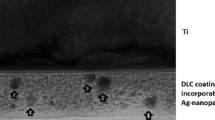Abstract
Background
For orthopedic implants, infection is a serious problem. Therefore, we considered an implant with antimicrobial ability can prevent infection. We tried to coat a titanium alloy surface with Novaron, a commercially available inorganic antimicrobial. The purpose of this study was to analyze the differences among the surfaces of materials coated using different processing pressures of the working gas and analysis of the antimicrobial activity.
Methods
One of the inorganic antimicrobials Novaron (grade VZ 600) was applied to titanium alloy (Ti6Al4V) plates. This antimicrobial has limited heat resistance, so we used cold spray technology to coat the titanium alloy with it. The principle of cold spray technology is spraying a powder in a high-velocity gas jet, accelerated by adiabatic expansion, against a substrate. Scanning electron microscopy (SEM) and energy dispersive X-ray spectrometry (EDS) were used to analyze the differences among the surfaces of materials coated using different processing pressures of the working gas. The Japanese Industrial Standard (JIS) method (JIS Z2801: 2000) was used to analyze the antimicrobial activity against Staphylococcus aureus, Pseudomonas aeruginosa, and Klebsiella pneumoniae. Antimicrobial activity was analyzed only for the sample coated at 3.0 MPa.
Results
The SEM and EDS results indicated that when the pressure of the working gas was increased, the antimicrobial coated the titanium adequately. This material showed good effects against S. aureus and P. aeruginosa and some effect for K. pneumoniae.
Conclusions
Antimicrobial implants represent a preventive method against infection. There is a possibility of using them not only for clean operations but also for operations with suspected bacterial contamination, such as fixation of slight compound fractures.
Similar content being viewed by others
References
Guinan JL, McGuckin M, Shubin A, Tighe J. A descriptive review of malpractice claims for health care-acquired infections in Philadelphia. Am J Infect Control 2005;33:310–2.
Arciola CR, Campoccia D, Gamberini S, Donati ME, Pirini V, Visai L, et al. Antibiotic resistance in exopolysaccharide-forming Staphylococcus epidermidis clinical isolates from orthopaedic implant infections. Biomaterials 2005;26:6530–5.
Price JS, Tencer AF, Arm DM, Bohach GA. Controlled release of antibiotics from coated orthopedic implants. J Biomed Mater Res 1996;30:281–6.
Stigter M, Bezemer J, de Groot K, Layrolle P. Incorporation of different antibiotics into carbonated hydroxyapatite coatings on titanium implants, release and antibiotic efficacy. J Control Release 2004;99:127–37.
Montali A. Antibacterial coating systems. Injury 2006;37:581–6.
Bright KR, Gerba CP, Rusin PA. Rapid reduction of Staphylococcus aureus populations on stainless steel surfaces by zeolite ceramic coatings containing silver and zinc ions. J Hosp Infect 2002;52:307–9.
Suketa N, Sawase T, Kitaura H, Naito M, Baba K, Nakayama K, et al. An antibacterial surface on dental implants, based on the photocatalytic bactericidal effect. Clin Implant Dent Relat Res 2005;7:105–11.
Ohko Y, Utsumi Y, Niwa C, Tatsuma T, Kobayakawa K, Satoh Y, et al. Self-sterilizing and self-cleaning of silicone catheters coated with TiO(2) photocatalyst thin films: a preclinical work. J Biomed Mater Res 2001;58:97–101.
Furno F, Morley KS, Wong B, Sharp BL, Arnold PL, Howdle SM, et al. Silver nanoparticles and polymeric medical devices: a new approach to prevention of infection? J Antimicrob Chemother 2004;54:1019–24.
Gosheger G, Hardes J, Ahrens H, Streitburger A, Buerger H, Erren M, et al. Silver-coated megaendoprostheses in a rabbit model: an analysis of the infection rate and toxicological side effects. Biomaterials 2004;25:5547–56.
Sakaki K, Shimizu Y. Effect of increase in entrance length of gun nozzle on HVOF and cold spray process. J Thermal Spray Technol 2001;10:487–96.
Papyrin A. Cold spray technology. Adv Mater Processes 2001;159: 49–51.
Japanese Standards Association. Antimicrobial products: test for antimicrobial activity and efficacy. Japanese Industrial Standard 2000;JIS Z 2801.
Ha KY, Chung YG, Ryoo SJ. Adherence and biofilm formation of Staphylococcus epidermidis and Mycobacterium tuberculosis on various spinal implants. Spine 2005;30:38–43.
Van der Borden AJ, van der Mei HC, Busscher HJ. Eletriccurrent-induced detachment of Staphylococcus epidermidis strains from surgical stainless steel. J Biomed Mater Res B Appl Biomater 2004;68B:160–4.
Author information
Authors and Affiliations
About this article
Cite this article
Tamai, K., Kawate, K., Kawahara, I. et al. Inorganic antimicrobial coating for titanium alloy and its effect on bacteria. J Orthop Sci 14, 204–209 (2009). https://doi.org/10.1007/s00776-008-1306-7
Received:
Accepted:
Published:
Issue Date:
DOI: https://doi.org/10.1007/s00776-008-1306-7




